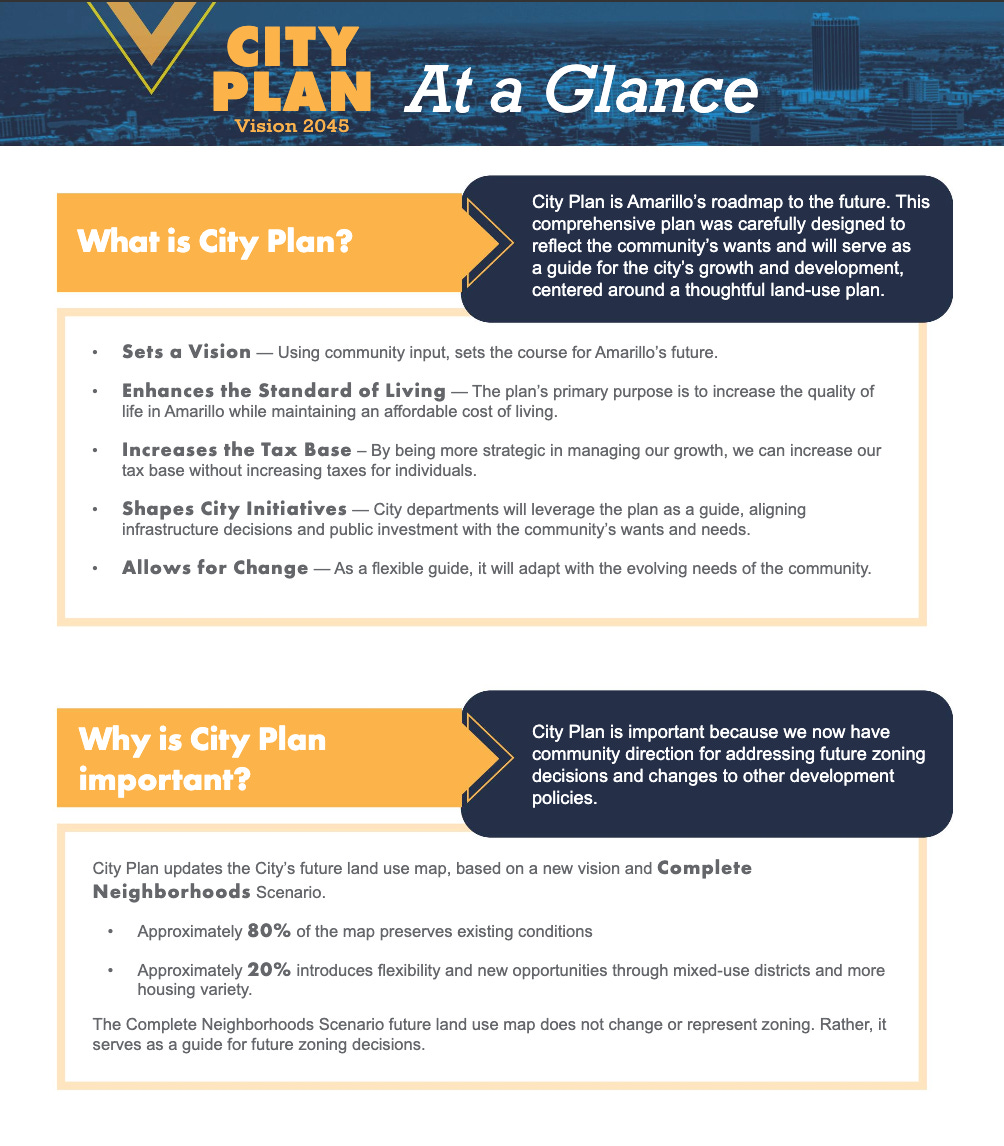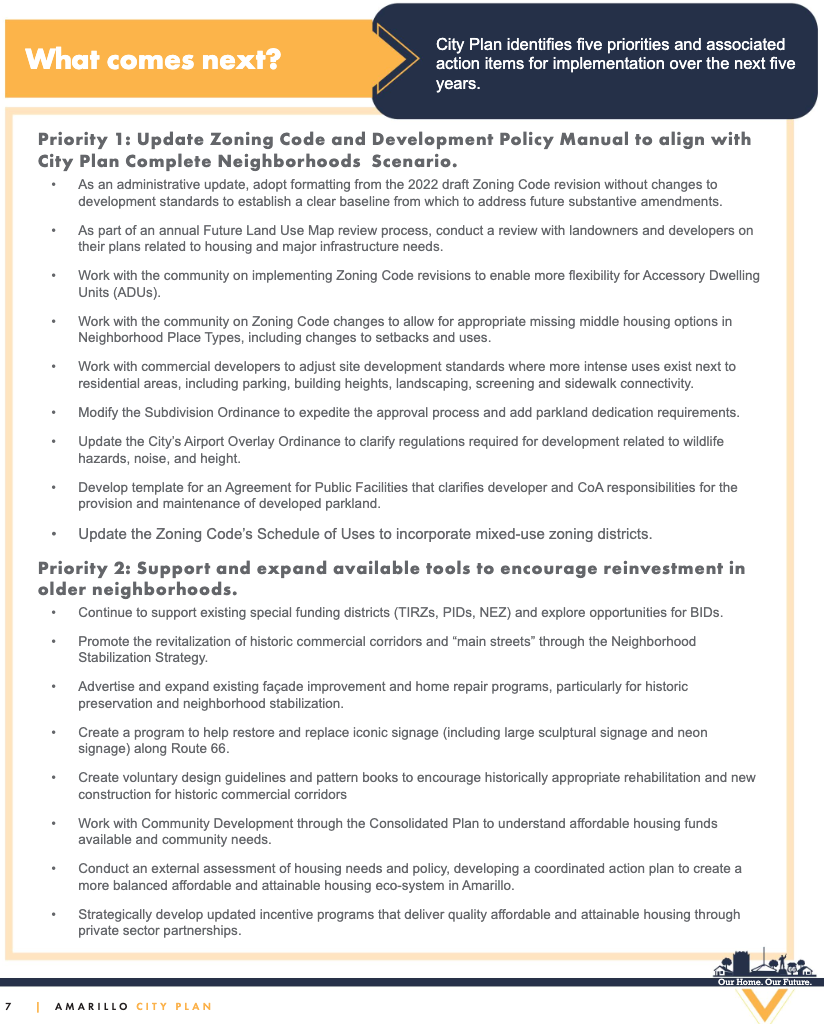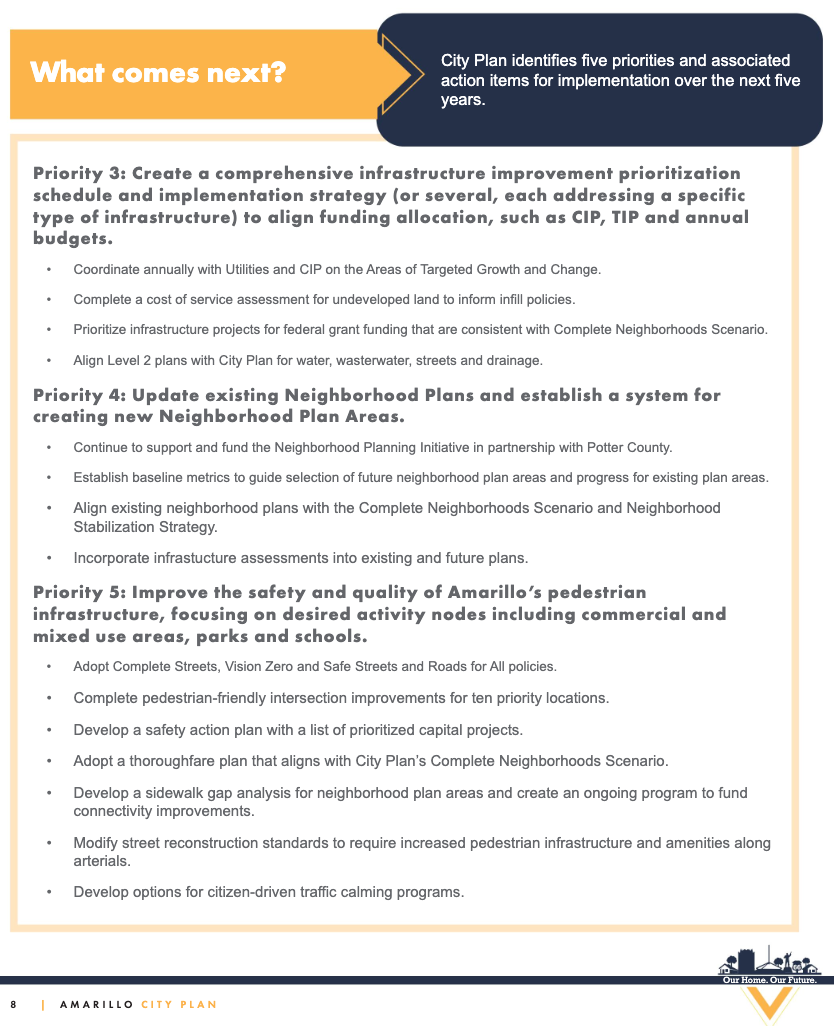From Pushback to Buy-In: How Amarillo Built a Comprehensive Plan People Could Trust
In a community wary of top-down planning, Amarillo won support by going grassroots, with precision, persistence, and plain language
When Amarillo set out to create a new comprehensive plan, the odds weren’t exactly stacked in its favor.
Recent attempts at code amendments had failed, including a rewrite of its 1960s-era zoning code as well as a controversial city-initiated rezoning in a historically Black neighborhood. Along the way came a near-total turnover on the City Council, followed by the revelation that “City Plan — Vision 2045” shared its title with a United Nations initiative, an unfortunate coincidence that lit up the local conspiracy crowd.
Last but certainly not least, there was no communications budget.
Despite it all, the plan passed unanimously. How the hell does that happen? That’s exactly the kind of story GGF was built to tell. But before we unpack how it happened, let’s talk Amarillo.
About Amarillo, Texas
Amarillo is the largest city in the Texas Panhandle, with a population just over 200,000. Located on the high plains of the Llano Estacado, it serves as a regional hub for agriculture, energy, and transportation. Demographically, the city is about 52% non-Hispanic White, 34% Hispanic, and 7% Black, with a growing immigrant population and a median age of 35. Known for its strong sense of independence and deep respect for property rights, Amarillo blends small-town values with big-city responsibilities.
A new team for a new approach
Planning Director Emily Koller realized early on the plan development process couldn’t follow the usual playbook. Public trust had to be earned, not assumed. And the City Council set a high bar for citizen support for any proposed changes.
“It really is a community-directed vision and it's very different from (other comp plans in Texas),” Koller said. “It’s very property rights forward.”
She made a key staffing move: hiring Shari Kendall as a full-time community engagement lead within the planning department. And when Joy Stuart reached out from the city’s communications office, they brought her in to work with their consultants to not just to promote the plan, but to help shape how they got input.
“This, like, perfect team assembled at the right time,” Koller said.
The thoughtful, well-executed citizen participation effort for the comp plan is paying dividends for the city, Koller said, noting they are “really starting to focus on engagement as an essential part of planning projects.”
Meeting the Council where they were
That trust from the City Council and the public was hard earned. Elected leaders told staff not to bring the plan forward for a vote unless they could prove residents understood it.
In a region where property rights loom large, that meant more than just explaining the map. It meant proving the city wasn’t trying to control it. Koller recalls providing an update to the City Council at the mid-point of the planning process and sharing the draft future land use map—the keystone of any comprehensive plan.
“They asked us, ‘Well, do people know what this means?’ They basically said, don’t come back to us with this plan unless you have a representative amount of people in Amarillo that understand this map and what it means to them.”
So the team doubled down on outreach. Check out this comprehensive approach and the metrics achieved:
Mailer sent to 103,380 residents, ensuring accessibility and inclusivity
Plan webpage garnered 6,841 views, serving as a hub for engagement and information dissemination
A “Students’ Voice” video received an impressive 7,200 views
Cross-platform social media strategy generated 176,262 impressions, sparking active participation and discussions. There were 617 comments, 9,831 clicks, and 226 shares
Three interactive workshops drew more than 200 participants who engaged in open conversations and feedback
Across nine community events, the team engaged face-to-face with residents and captured more than 500 comments, questions, and concerns
Local media coverage helped reach English and Spanish-speaking community members, further enhancing inclusivity and engagement
All told, the campaign resulted in more than 4,000 participants actively contributing to the development of the plan.
Here’s the “Students’ Voice” video that was so effective. Talk about putting a human (and adorable) face on the importance of the plan for Amarillo’s future.
Meeting residents where they are at
Of all the outreach efforts, the most effective may have been the Community Connectors program, which reached residents through trusted messengers in 54 of the 68 neighborhoods in the city.
“I felt like it was essential as a way to demonstrate to council that we had talked to people and they actually understood what it meant and what the impacts were,” Koller said. “And I think we learned that people really engaged at the neighborhood scale.”
The neighborhood focus was critical, said Kendall, the citizen engagement specialist. They held “lunch and learns” where staff would explain the need for a comprehensive plan and provide an overview of the plan’s proposals. Then they would pull out of a map of a neighborhood to identify the current zoning and share what was proposed in the plan.
“You know, it just breaks it down onto a more personal level, and it’s easier to explain rather than all of Amarillo,” she said.
Stuart added: “And so important, too. It’s all about trust building, like, ‘Hey, you care about us.’”
This was part of the broader effort to show residents the city was listening.
“People would say, ‘The city doesn’t want to hear from us,’” Stuart said. “And we’d say, ‘No, especially if you think that, you’re exactly who we want to hear from.’”
Stuart learned about the Community Connectors concept during a a Bloomberg Harvard course on civic engagement. It’s a reminder that continuing education isn’t a nice-to-have; it’s a catalyst for high-impact communication. (I cover this point in my High Performance Communications series. See this post on the role of organizational leadership.)
“Even though the cities represented were so dynamically different (in the course), one of the key takeaways is this idea of going to where people are for engagement,” Stuart said.
Plain language, real conversations
One of the most effective components of the citizen participation effort? Simple, relatable language.
“I love to take complex government wordage … and translate that into regular human understanding,” Stuart said.
Here’s the inside cover of the plan, which demonstrates Stuart’s ability to keep it simple. It clearly articulates the What and Why driving the planning initiative.
No boilerplate allowed
Amarillo worked with consultants on the technical elements, but it was the in-house team that ensured the outreach plan met the city council and community expectations.
“We had to fine-tune it in certain ways because of how our community responds,” Stuart said.
That tailoring extended all the way to implementation. Rather than burying action items in a long matrix, the team built a five-year roadmap that elected officials and staff can actually use.
“We spent a lot of time on a very concise implementation,” said Koller. “That’s how we’ll know we were successful—if, in five years, we’ve done what we said we’d do.”
Here are the implementation priorities.
As those priorities are achieved—and GGF may very well do a deep dive on the Safe Streets initiative approved earlier this year—the trust established with the public and elected leaders during the Vision 2045 process will only deepen. (My gut tells me the Zoning Code update attempted in 2022 now stands a great chance of passing.)
The final test
At the end of the process, last June, when it came time for the city council vote, Koller gave the final presentation herself—not the consultants, as typically occurs with these kinds of projects.
“The final presentation was really odd,” Koller said. “We didn’t have our consultants do it. I had to address all these things about property rights and, yeah, the UN agenda, and I literally had to refute those things with this council, all while presenting the important concepts of the plan, like the engagement. I thought it was a pretty tall ask for a presentation. So that’s like, one of the highlights of my career, honestly, is getting through that presentation successfully just because it was so different. And the way I had to include information and not take more than 15 minutes.”
The vote? Unanimous.
City Plan — Vision 2045 won the prestigious Comprehensive Planning Award from the Texas chapter of the American Planning Association, as well as earning first place honors from national and state communications professionals for outreach and community engagement.
Why it worked
Amarillo didn’t just write a better plan—it changed the planning process itself. It aligned staff, residents, and elected officials through a shared language, a tailored message, and meaningful engagement.
And it never lost sight of the most important question in any public process: Why should this matter to me?
Onward and Upward.




